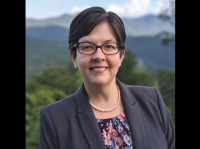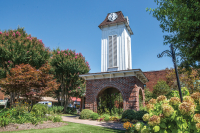Reading between the census lines
Although population in Western North Carolina increased only by a modest amount over the past decade, home construction grew at a much higher rate, according to 2010 census data released last week.
The census counts year-round residents. But much of the growth in WNC has come from second homes — and as a result isn’t reflected when looking at population numbers alone.
Hard data on the number of second homes and the region’s summertime population can be difficult to ferret out. But the latest census shows the growth in housing units has outpaced population growth, confirming the second home dynamic that people who live here year-round witness.
ALSO: See the graphs
“You can definitely feel when summer season is coming back,” said David Francis, a Haywood County resident and the head of the county tax department. “You can just tell from the traffic on a Friday afternoon. Where I really see it is at Ingle’s.”
While long lines and empty shelves at the grocery store are a sure sign that the seasonal population has returned, the summer influx of residents is witnessed in every facet of society, from more trash at the landfill to more people at the emergency room.
Related Items
Seasonal residents translate into a 15 to 20 percent increase in trash at the Haywood County landfill, Francis said.
The emergency room at MedWest Harris in Sylva sees a seasonal spike in patient volume of 10 to 15 percent during the summer and fall compared to winter, according to numbers provided by Lucretia Stargill, a MedWest spokesperson. Ambulance calls likewise increase in the summer, according to Jim Pressley, the EMS director for Haywood County.
In Maggie Valley, a town full of vacation homes, users at the town library go way up in summer, according to Town Manager Tim Barth. So does the need for police officers. It means the department is slightly overstaffed in the off-season.
“Right now there may not be a lot of people in the Valley. But you can’t just hire police officers for two or three months. That doesn’t work very well,” Barth said.
Running a community with such seasonal population swings isn’t easy. It must have adequate infrastructure to serve the larger population. In Maggie Valley, the sewer treatment plant has a much larger capacity than its year-round population of 1,100 would typically dictate.
“We have to assume that everybody will be in Maggie Valley all at one time, and that is what we have to plan for,” Barth said.
While thousands of seasonal Maggie residents make a wintertime exodus back to Florida, they continue paying a sewer bill of $15 a month while they’re gone, even if their water is completely shut off, Barth said. The minimum monthly bill allows the sewer treatment plant to be keep operating during those months and be in working order when the masses return.
The building surge of the past decade forced counties to grapple with all kinds of infrastructure issues. Ken Brown, Chairman of the Tuckasegee Community Alliance in Jackson County, pointed to the dispute between the Glenville Fire Department and second-home owners on an island in the middle of the lake. The second-home owners wanted the volunteer fire department to provide fire service, even if it meant taking a fire truck across the lake on a barge.
“I thought it was offensive actually they could buy an island then demand the county provide them fire service,” Brown said.
Second-home growth also takes its toll on natural resources, from construction-site erosion muddying the streams to view-obscuring smog from vehicles.
Public lands, which are home to the last remaining Appalachian ecosystems, are also feeling the squeeze. As development spreads across the landscape, it’s pushing up against the Pisgah and Nantahala national forests and encroaching on wildlife habitat. The National Forest Service ranked the Pisgah and Nantahala among the top five forests threatened by periphery development in a 2009 report called “National Forests on the Edge.”
Meanwhile, more people are recreating in the national forests, testing the carrying capacity of the public lands that make WNC such a desirable place to live, according to Brent Martin, the Southern Appalachian director of The Wilderness Society in Sylva.
How many second homes?
Mark Clasby has spent much of the past decade trying to quantify the second-home market in Haywood County.
“It is a very important part of our economy,” said Clasby, the county economic development director.
The potential buying power of Haywood County’s population can make or break whether a new business comes here. Clasby has been trying to pedal a mega commercial site once slated for a Home Depot that was cancelled after the recession took hold. Finding a retailer of that magnitude to fill the void has been tough.
“What they tend to look at when they pick a location is they want to know what the population is,” Clasby said. “We try to make an argument that we have more people here than what census numbers show. What I have to use is unscientific.”
One figure Clasby points to is the number of property tax bills mailed out of the county. In Haywood County, one-third of tax bills are mailed out of the county, indicating the property owner has a primary residence somewhere else. In Macon County — an even bigger second-home market — 54 percent of tax bills are mailed out of the county.
Five years ago, the Downtown Waynesville Association commissioned a study on where shoppers come from. Over 70 businesses throughout town recorded the zip codes of those making purchases, including those who were second-home owners. Second-home owners accounted for 12 percent of shoppers at participating shops the last week in July.
But second-home residents aren’t just here in the summer anymore.
“I think our seasonal folks increase starting in the spring and go into the fall and some all the way through the holidays,” said Linda Schlott, the director of the Main Street Program in Franklin.
And that’s good news for business owners.
“We can see an increase in people on the streets and merchants see an influx of customers when those seasonal visitors are here,” Schlott said.
Some second-home owners actually live here more months of the year than they do in their so-called primary residence. But the absence of income tax in Florida makes it advantageous to claim that state as their permanent residence.
Real numbers at last
The census offers a glimpse into just how many homes in our midst may be second homes or vacation rentals. To census workers, any house not occupied by a full-time resident was designated “vacant.”
In Haywood, 27 percent of homes were deemed “vacant.” In Swain, it was 35 percent. In Jackson, it was 37 percent. And in Macon it was a whopping 42 percent (see chart).
The numbers are even more staggering in quintessential vacation and second-home markets. In the town of Maggie Valley, two-thirds of the housing units were “vacant.” In the town of Highlands, “vacant” homes account for 78 percent of the housing stock.
A small portion of the housing units deemed “vacant” by the census are truly that. There’s a baseline of legitimately vacant houses, such as rentals that are between renters or empty houses where the owner has died.
Statewide, the average vacancy rate is only 13 percent. That average includes places like the beach and the mountains with a preponderance of vacation condos and second homes. For a typical city where these aren’t a factor, like Greensboro or Durham, the vacancy rate is 9 to 10 percent.
In Jackson County, student housing contributes to the high percentage of “vacant” housing units. Several apartment buildings have gone up over the past decade aimed at students attending Western Carolina University. Perhaps too many apartments, said Mark Jamison, a resident of nearby Webster. The university predicted exponential growth of students that hasn’t materialized completely.
“You have an inventory created on suppositions that probably aren’t going to come true,” Jamison said.
Another factor in the number of vacant homes on the census roster is speculative building. During the boom years, the line of prospective second-home buyers seemed endless, prompting developers to build spec houses rather than merely sell off lots. Some contractors would even buy lots to build spec homes of their own.
But when the stream of buyers dried up, those homes were left standing, explained Danny Wingate, the vice president of Haywood Builders.
Sitting idle
The 2010 Census reveled a high number of second homes not occupied by year-round residents. Here’s the percentage of “vacant” homes by county.
Haywood 27 percent
Jackson 37 percent
Macon 42 percent
Swain 35 percent
Total housing units by county:
Haywood 34,954
Jackson 25,948
Macon 25,245
Swain 8,723









